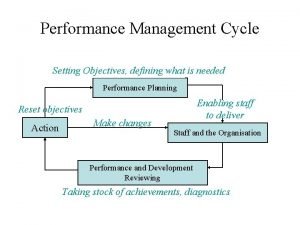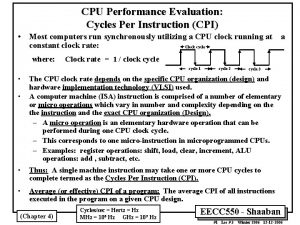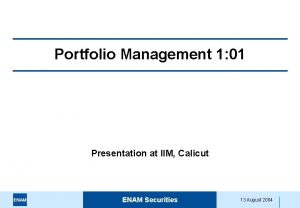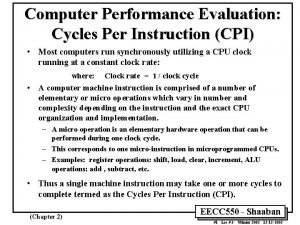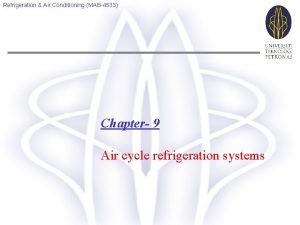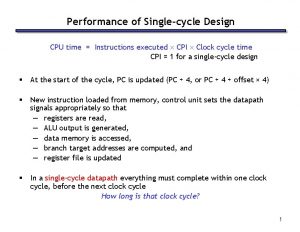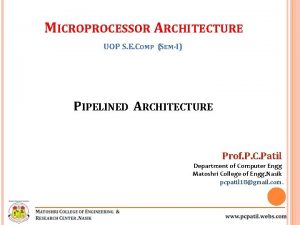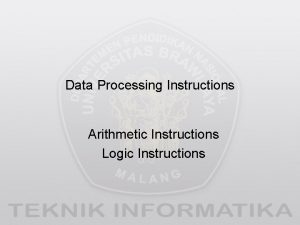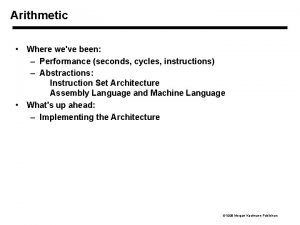1 Time Instructions Cycles Time x x Performance
























































- Slides: 56


Ο “Νόμος” της απόδοσης των μικροεπεξεργαστών 1 Time Instructions Cycles Time _________ ______ = = x x Performance Program Instruction Cycle (instr. count) (CPI) (cycle time) IPC x Hz _____ → Performance = instr. count • clock speed (↑Hz) • αρχιτεκτονικές βελτιστοποιήσεις (↑IPC): pipelining, superscalar execution, branch prediction, out-of-order execution • cache (↑IPC) cslab@ntua 2015 -2016 2






Πολυνηματισμός • Πλεονεκτήματα • Δε χρειάζεται dependency checking μεταξύ των εντολών • Δε χρειάζεται branch prediction • Αποφυγή bubbles πραγματοποιώντας χρήσιμη δουλειά από άλλα threads • Βελτίωση system throughput, utilization, latency tolerance • Μειονεκτήματα • Πολυπλοκότητα hardware (PCs, register files, thread selection logic, …) • Χειρότερο single thread performance (1 instruction every N cycles) • Yψηλός ανταγωνισμός για πόρους (resource contention for caches & memory) cslab@ntua 2015 -2016 8

Για αρκετές εφαρμογές, οι περισσότερες μονάδες εκτέλεσης σε έναν Oo. O superscalar μένουν ανεκμετάλλευτες Αποτελέσματα για 8 -way superscalar. cslab@ntua 2015 -2016 [Tullsen, Eggers, and Levy, “Simultaneous Multithreading: Maximizing On-chip Parallelism, ISCA 1995. ] 9

ΟοΟ superscalar • horizontal waste: εξαιτίας χαμηλού ILP • vertical waste: εξαιτίας long-latency γεγονότων – cache misses – pipeline flushes λόγω branch mispredictions cslab@ntua 2015 -2016 10








Τι προστέθηκε. . . cslab@ntua 2015 -2016 18





Pentium 4 w/ Hyper-Threading: Execution engine • Allocator: εκχωρεί entries σε κάθε LP – – – 63/126 ROB entries 24/48 Load buffer entries 12/24 Store buffer entries 128/128 Integer physical registers 128/128 FP physical registers • Σε ταυτόχρονη ζήτηση από τους 2 LPs, η πρόσβαση εναλλάσσεται κύκλο-ανά-κύκλο • stall-άρει έναν LP όταν επιχειρεί να χρησιμοποιήσει περισσότερα από τα μισά entries των στατικά διαχωρισμένων πόρων cslab@ntua 2015 -2016 23

Pentium 4 w/ Hyper-Threading: Execution engine • Register renaming unit – επεκτείνει δυναμικά τους architectural registers απεικονίζοντάς τους σε ένα μεγαλύτερο σύνολο από physical registers – ξεχωριστό register map table για κάθε LP cslab@ntua 2015 -2016 24



Multithreaded speedup • SPLASH 2 Benchmarks: 1. 02 – 1. 67 From: Tuck and Tullsen, “Initial Observations of the Simultaneous Multithreading Pentium 4 Processor”, PACT 2003. • NAS Parallel Benchmarks: 0. 96 – 1. 16 cslab@ntua 2015 -2016 27

Case-study 2 Power 5 : επέκταση του Power 4 για υποστήριξη SMT (2004) • Single-threaded «προκάτοχος» του Power 5 • 8 execution units – 2 Float. Point, 2 Load/Store, 2 Fixed Point, 1 Branch, 1 Conditional Reg. unit – κάθε μία μπορεί να κάνει issue 1 εντολή ανά κύκλο • Execution bandwidth: 8 operations ανά κύκλο – (1 fpadd + 1 fpmult) x 2 FP + 1 load/store x 2 LD/ST + 1 integer x 2 FX cslab@ntua 2015 -2016 28

Power 4 Power 5 2 commits (architected register sets) 2 fetch (PC), 2 initial decodes cslab@ntua 2015 -2016 29

SMT resource management cslab@ntua 2015 -2016 30





Power 5 datapath • Issue, execute, write-back – δε γίνεται διάκριση ανάμεσα στα 2 threads • Group completion (στάδιο CP) – 1 group commit ανά κύκλο για κάθε thread – στη σειρά προγράμματος του κάθε thread cslab@ntua 2015 -2016 35




“Large” vs. “Small” Cores Large Core Out-of-order Wide fetch e. g. 4 -wide Deeper pipeline Aggressive branch predictor (e. g. hybrid) • Multiple functional units • Trace cache • Memory dependence speculation • • Small Core In-order Narrow Fetch e. g. 2 -wide Shallow pipeline Simple branch predictor (e. g. Gshare) • Few functional units • • Large Cores are power inefficient: e. g. , 2 x performance for 4 x area (power) cslab@ntua 2015 -2016 39

Large vs. Small Cores • Grochowski et al. , “Best of both Latency and Throughput, ” ICCD 2004. cslab@ntua 2015 -2016 40


Ultra. SPARC T 1 • in-order, single-issue – επικεντρώνεται πλήρως στην εκμετάλλευση του TLP • 4 -8 cores, 4 threads ανά core – max 32 threads – fine-grained multithreading • L 1 D + L 1 I μοιραζόμενες από τα 4 threads • L 2 cache + FPU μοιραζόμενη από όλα τα threads • ξεχωριστό register set + instruction buffers + store buffers για κάθε thread cslab@ntua 2015 -2016 42



Ultra. SPARC T 1 pipeline cslab@ntua 2015 -2016 45

Ultra. SPARC T 1 performance • fine-grained multithreading μεταξύ 4 threads → ιδανικό perthread CPI = 4 • ιδανικό per-core CPI = 1 • effective CPI = per-core CPI / #cores • effective throughput: μεταξύ 56% και 71% του ιδανικού cslab@ntua 2015 -2016 46


Λόγοι για τη μη διαθεσιμότητα ενός thread • pipeline delay: long-latency εντολές όπως branches, loads, fp, int mult/div cslab@ntua 2015 -2016 48

«Crash-test» multicore επεξεργαστών (~2005) • βασικές διαφορές: – εκμετάλλευση ILP vs. TLP (Power 5 → Opteron, Pentium D → T 1) – floating point performance (Power 5 → Opteron, Pentium D → T 1) – memory bandwidth (T 1 → Power 5 → Opteron → Pentium D) » επηρεάζει την απόδοση εφαρμογών με μεγάλο miss rate cslab@ntua 2015 -2016 49

«Crash-test» multicore επεξεργαστών cslab@ntua 2015 -2016 50

«Crash-test» multicore επεξεργαστών (~2010) AMD Opteron 8439 IBM Power 7 Intel Xenon 7560 Sun T 2 Transistors (M) 904 1200 2300 500 Power (W) 137 140 130 95 Max cores/chip 6 8 8 8 Mutlithreading No SMT Fine-grained Threads/ core 1 4 2 8 Instr. issue/clock 3 from 1 thread 6 from 1 thread 4 from 1 thread 2 from 2 threads Clock rate (GHz) 2. 8 4. 1 2. 7 1. 6 Outermost cache Inclusion Coherence protocol Coherence implementation Extended coherence support cslab@ntua 2015 -2016 L 3, 6 MB, shared L 3, 32 MB, shared or L 3, 24 MB shared private/core L 2, 4 MB, shared No Yes Yes MOESI Extended MESIF MOESI Snooping L 3 Directory L 2 Directory Up to 8 processor chips (NUMA) Up to 32 processor chips (UMA) Up to 8 processor cores Up to 2/4 chips (directly/external ASICs) 51

Tile-Large Approach Large core “Tile-Large” • Tile a few large cores • IBM Power 5, AMD Barcelona, Intel Core 2 Quad, Intel Nehalem + High performance on single thread, serial code sections - Low throughput on parallel program portions cslab@ntua 2015 -2016 52

Tile-Small Approach Small core Small core Small core Small core “Tile-Small” • Tile many small cores • Sun Niagara, Intel Larrabee, Tilera TILE (tile ultra-small) + High throughput on the parallel part (16 units) - Low performance on the serial part, single thread (1 unit) cslab@ntua 2015 -2016 53 53

Asymmetric Chip Multiprocessor (ACMP) Large core “Tile-Large” Small core Small core Small core Small core Small core “Tile-Small” Small core Small core Small core Large core ACMP • Provide one large core and many small cores + Accelerate serial part using the large core + Execute parallel part on small cores and large core for high throughput cslab@ntua 2015 -2016 54

Today: Many Cores on Chip • Simpler and lower power than a single large core • Large scale parallelism on chip Intel Core i 7 AMD Barcelona 8 cores IBM Cell BE IBM POWER 7 Intel SCC Tilera TILE Gx 8+1 cores 8 cores 4 cores Sun Niagara II Nvidia Fermi 448 “cores” 48 cores, networked 100 cores, networked 8 cores cslab@ntua 2015 -2016 55

Chips Today (2010 -2014) • Intel Nehalem (~2010) • slides by Krste Asanovic (Berkeley, CS 152 - link) • Hot. Chips 2012 (HC 24 http: //www. hotchips. org/archives/hc 24/ ) • • Intel’s 3 rd generation processors Ivy Bridge (link) AMD’s Jaguar next generation low power x 86 core (link) Knight’s Corner - Intel’s MIC (link) Power 7+ (link) • Hot. Chips 2013 (HC 25 http: //www. hotchips. org/archives/hc 25/ ) • Power 8 (link) • Intel’s 4 th generation processors Haswell (link) • Hot. Chips 2014 (HC 26 http: //www. hotchips. org/archives/hc 26/ ) • • cslab@ntua 2015 -2016 AMD’s Kaveri APU (link) AMD’s Opteron A 1100 (link) Next generation SPARC Processor Cache Hierarchy (link) Intel C 2000 Atom Microserver (link) NVIDIA’s Denver Processor (link) MIT Scorpio (link) Powering the Io. T (link) 56
 Biogeochemical cycles performance task
Biogeochemical cycles performance task Explain the performance management cycle
Explain the performance management cycle Mandarin cycles
Mandarin cycles Alliteration of cycle
Alliteration of cycle Importance of water cycle
Importance of water cycle Pdsa cycle nursing
Pdsa cycle nursing Precession milankovitch cycles
Precession milankovitch cycles Similarities between frog and butterfly
Similarities between frog and butterfly Relationship between transaction cycles
Relationship between transaction cycles Cpi cycles per instruction
Cpi cycles per instruction Apes nutrient cycles
Apes nutrient cycles The major abiotic reservoir for phosphorus is
The major abiotic reservoir for phosphorus is Biogeochemical cycles quiz
Biogeochemical cycles quiz Cycles in nature
Cycles in nature Joke cycles
Joke cycles Joke cycles
Joke cycles Biogeochemical cycles class 9 ppt
Biogeochemical cycles class 9 ppt Sleep wake cycles
Sleep wake cycles Cell cycle foldable project
Cell cycle foldable project Design science research cycles
Design science research cycles Compare and contrast carbon and nitrogen cycles
Compare and contrast carbon and nitrogen cycles Biogeochemical cycles poster
Biogeochemical cycles poster Adopsi dalam pdca
Adopsi dalam pdca Blogspot
Blogspot Water cycles of matter
Water cycles of matter Isagenix pay structure
Isagenix pay structure Multiplication of cycles
Multiplication of cycles Cpi in cpu
Cpi in cpu Tidal patterns
Tidal patterns Life cycles of a bird
Life cycles of a bird 4 major biogeochemical cycles
4 major biogeochemical cycles Nitrogen cycle pearson education
Nitrogen cycle pearson education Section 26.3 life cycles of stars
Section 26.3 life cycles of stars Mandarin cycles
Mandarin cycles Tsw cycles
Tsw cycles Business cycles economics
Business cycles economics Mesa and trading market cycles pdf
Mesa and trading market cycles pdf Per capita real gdp formula
Per capita real gdp formula Essay on global warming
Essay on global warming End-to-end procurement life cycle
End-to-end procurement life cycle Biogeochemical cycles
Biogeochemical cycles Rolling thunder cycles
Rolling thunder cycles Milankovitch cycles
Milankovitch cycles Milankovitch cycles
Milankovitch cycles 3-3 cycles of matter
3-3 cycles of matter Life cycle of a star
Life cycle of a star Solid rock cycles
Solid rock cycles Actual air refrigeration system
Actual air refrigeration system Fadlife
Fadlife Plant life cycles and alternation of generations
Plant life cycles and alternation of generations Cpi cycles per instruction
Cpi cycles per instruction Nutrient cycles
Nutrient cycles ……………types of bus cycles / operations in 80386dx
……………types of bus cycles / operations in 80386dx 아두이노 타이머 인터럽트 2개
아두이노 타이머 인터럽트 2개 Lesson 2 cycles of matter answer key
Lesson 2 cycles of matter answer key Rock.cycle
Rock.cycle Solid rock cycles
Solid rock cycles

